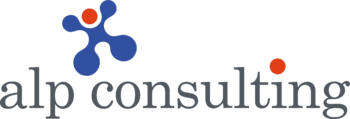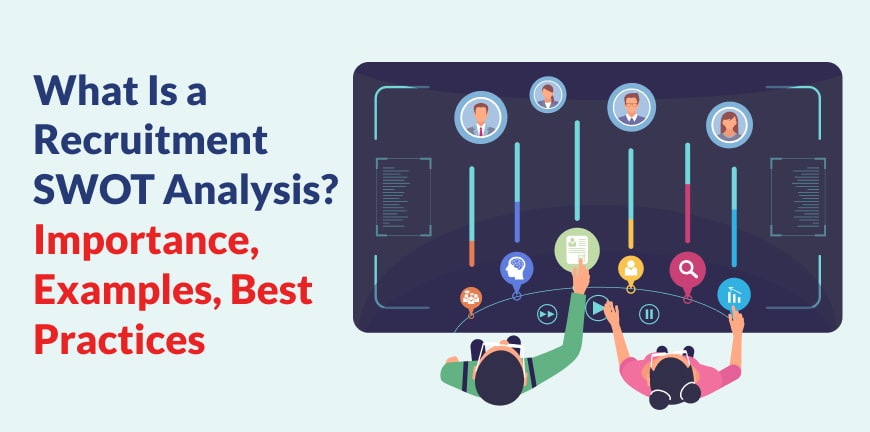
Sources of Recruitment: Types, Advantages, Importance, Methods
13/06/2025
Challenges Faced by Japan-Based Companies for Recruiting in India
16/06/2025The business market is dynamic and unforgiving, always keeping companies on their toes like a cat on a hot tin roof. Companies offering services and products to their clients and end customers must quickly adapt to these changes and get a head start over their competitors. A robust recruitment process is essential for maintaining business continuity and brand value.
The HR team can’t sit back and hope the existing hiring policies and practices will pull through under all circumstances. Continuous improvement is the only way forward for the HR team to attract and retain top talent for the business to flourish amid stiff competition. If the current hiring processes are not working effectively, then the best option is to “go back to the drawing board and bring out the SWOT team into the mix”.
A SWOT analysis is a guiding torch for the HR team to help them relook at their current hiring frameworks and identify pros and cons and address them accordingly. Let’s understand how SWOT analysis in recruitment can be used effectively to improve the hiring process and achieve continued success in talent acquisition.
What Is a SWOT Analysis in Recruitment?
A mapping tool utilised by the HR department to identify Strengths, Weaknesses, Opportunities, and Threats associated with their recruitment practices, policies, and execution is known as SWOT analysis in recruitment. Using the SWOT findings, the HR team develops an action plan to improve hiring practices that fetch positive outcomes in the long run.
Companies can gain valuable insights into internal capabilities & external conditions affecting talent acquisition through the effective use of SWOT analysis for hiring strategies. This approach helps the HR team to streamline their hiring processes and achieve outcomes that ensure hiring practices are in line with organisational goals.
Here is a glimpse of the general SWOT parameters considered for analysis in the recruitment process for most companies.
1. Strengths
Strong employer brand, competitive salary, efficient hiring process, experienced HR team, and good candidate experience from screening to onboarding are considered to be strengths of a high-performing HR team.
2. Weaknesses
Limited talent pool access, outdated recruitment tech, poor candidate engagement, long hiring cycles, and weak internal mobility can be the weak points in most HR teams across sectors.
3. Opportunities
Remote hiring access, AI recruitment tools, employer branding, talent from emerging markets, and campus hiring partnerships can be leveraged by HR teams to improve hiring methodologies.
4. Threats
Stiff competition, lack of skills, economic instability, regulatory amendments, and increasing candidate expectations must be mitigated proactively by HR teams to stay ahead of competitors.
Why Is SWOT Analysis Important in Recruitment?
A well-strategised SWOT analysis in recruitment can accelerate business growth and support brand growth. The optimised hiring processes and practices developed based on SWOT findings ensure that only top talents join the workforce and drive long-term success.
By conducting an end-to-end assessment of all contributing factors related to recruitment from the SWOT (Strengths, Weaknesses, Opportunities, and Threats) perspective, organisations can gain a more objective understanding of their hiring environment, identify discrepancies and gaps in real time, and make informed decisions.
Below are key reasons why a SWOT analysis of recruitment and selection is essential for long-term talent acquisition success.
1. To Assess Internal Capabilities
Recruitment teams or the think tank with the responsibility of improving hiring practices must collaborate with the leadership group and stakeholders to gauge current strengths and weaknesses. The elements to be assessed include hiring speed, candidate experience, sourcing tools, onboarding mechanisms, and others. Areas for improvement must be identified, and a strategic action plan should be developed to tackle the challenges using a SWOT matrix in recruitment.
2. To Understand Market Dynamics
External factors such as talent demand, labour market dynamics, technological advancements, competitor strategies, demographic shifts, cultural trends, etc., influence hiring. SWOT analysis HR recruitment helps track these dynamics and modify recruitment practices accordingly.
3. To Build a Data-Driven Strategy
Conducting a SWOT analysis in hiring ensures decisions aren’t assumption-based or guesswork but rather rely on concrete data. It facilitates the development of a structured framework for creating a recruitment plan based on real insights and evidence.
4. To Identify Gaps and Risks
SWOT helps uncover hidden issues such as poor candidate engagement, unethical practices, lack of recruitment actionable recruitment data, and compliance risks that may affect hiring success if left unattended.
5. To Prepare for Future Challenges
Labour markets are volatile and subject to unforeseen changes. A SWOT analysis in recruitment equips HR teams with the required acumen to anticipate future hiring difficulties and build flexible, resilient recruitment strategies.
How Can You Conduct a Recruitment SWOT Analysis?
Here is a step-by-step guide to conducting an effective SWOT analysis in recruitment:
Step 1: Set up a Clear Objective:
The company must find a clear motive behind conducting a SWOT analysis for recruitment process. Some of the reasons for initiating a SWOT analysis in hiring include:
- Enhancing hiring quality
- Reduce turnover rates.
- Ensuring policies and hiring practices are compliant.
- Identify potential risks.
- Improve decision-making in hiring.
The HR and recruitment department must evaluate the above reasons and identify improvement areas.
Step 2: Gather Data
Collecting all the necessary data is critical for conducting an effective SWOT analysis of recruitment and selection. It involves:
Internal Research
The HR team or the think tank must gather insights from current employees, managers, and leadership groups regarding the advantages and disadvantages of HR policies, operations, and practices.
Conduct a detailed survey to assess employee satisfaction levels and collect feedback. Also, ask candidates to share feedback on their overall interview experience from the initial phone call to the final managerial round. Keep all the collected data in an easy-to-sort format for further SWOT analysis.
External Research
The recruitment team must conduct external research and collect data on job market trends, competitors’ recruitment strategies and success rates, industry trajectory, talent pool availability in different sectors, etc. These data can be useful in providing insights and setting benchmarks for creating smart hiring strategies for the best outcomes.
Step 3: Create the SWOT Matrix in Recruitment
Create a SWOT matrix by categorising and placing all the contributing factors into the 4 quadrants labelled Strengths, Weaknesses, Opportunities, and Threats. A visual representation of the SWOT matrix helps the HR team organise their thoughts and generate recommendations on the improvement areas based on SWOT results.
Here is an example of a SWOT matrix in recruitment:
| Strengths | Weaknesses |
| Best Candidate Experience | Onboarding delays |
| Expert recruitment team | Lack of funds |
| Opportunities | Threats |
| Access to the Gig market | Strong competition from similar service providers |
| Adoption of AI-powered hiring methods | Labour law amendments |
Step 4: Identify Factors
Gather all the data related to recruitment and place them in the 4 quadrants in the SWOT matrix based on how they are performing against the benchmark.
- The strengths may include high brand value, strong company culture, use of technology in the hiring process, etc.
- Weaknesses may encompass poor candidate experience, delay in sending offer letters, complex background checks, etc.
- Opportunities might be emerging job markets, technological advancements in hiring technologies, etc.
- Threats might be changing labour laws, economic instability, etc.
Step 5: Analyse Findings
Once the SWOT matrix in recruitment is populated, analyse all the listed factors placed in the 4 quadrants.
- Detect patterns between opportunities and strengths and see how they can be leveraged for success.
- Identify threats and weaknesses to create mitigation strategies for preventing complications.
Step 6: Develop Action Plans
Based on the findings, develop a SWOT analysis for hiring strategies:
- Leverage strengths in a better way: Use employer branding and great candidate experience in marketing campaigns to attract top talent.
- Address weaknesses: Streamline the recruitment process to improve the hiring quality.
- Take advantage of opportunities: Collaborate with top colleges across India to tap emerging talents.
- Eliminate threats: Develop mitigation strategies to combat market instabilities, lack of talent in niche domains, etc.
What Are Common Examples of SWOT Factors in Recruitment?
Here is the table of SWOT analysis recruitment examples that most companies experience in their hiring practices.
| Strengths | Weaknesses |
| Strong employer brand | Limited sourcing channels |
| An efficient applicant tracking system (ATS) | Slow interview process |
| Skilled recruitment team | Inadequate candidate engagement strategy |
| Competitive compensation packages | Poor internal communication on hiring needs |
| Opportunities | Threats |
| Access to remote global talent | High competition for top talent |
| AI and automation in screening | Frequent changes in labour laws |
| Growing talent pool from upskilling trends | Rising salary expectations |
| University and campus hiring partnerships. | Economic instability is impacting hiring budgets. |
What are the Best Practices for Swot analysis in Recruitment?
Here are the best practices for conducting an effective SWOT analysis in recruitment:
1. Ensure Key Stakeholders are involved
Include hiring managers, recruitment team, and leadership to gather various perspectives and insights to conduct a well-rounded recruitment SWOT matrix analysis.
2. Use Data-Driven Insights
Run the SWOT analysis HR recruitment based on hiring metrics, candidate feedback on the overall interview experience, and market trends to ensure accurate and actionable findings for creating improvement strategies.
3. Focus on Specific Roles or Goals
Align SWOT analysis in recruitment based on departments, job types, or hiring objectives for more targeted strategy development.
4. Review and Update Regularly
Conduct a SWOT analysis periodically to align the hiring practices to market shifts, company growth, and evolving recruitment challenges.
5. Turn Insights into Action Plans
Translate SWOT findings into clear recruitment strategies, improvement plans, and performance benchmarks for measurable outcomes.
Frequently Asked Questions (FAQs)
1. What is a SWOT analysis in recruitment?
A SWOT analysis in recruitment evaluates internal strengths and weaknesses, and external opportunities and threats, helping organisations build informed, strategic hiring plans aligned with business goals.
2. How does SWOT analysis help in recruitment strategy?
A SWOT analysis in hiring highlights what’s working, what needs improvement, and external trends, enabling HR teams to align hiring efforts with company objectives and improve overall recruitment effectiveness.
3. Who should be involved in a recruitment SWOT analysis?
Recruiters, hiring managers, HR leaders, and department heads should collaborate to provide insights, ensuring a well-rounded analysis of recruitment capabilities and challenges from multiple perspectives.
4. How often should you conduct a recruitment SWOT analysis?
Ideally, a SWOT analysis for recruitment process should be done annually or during major business changes, such as expansions, restructures, or market shifts, to keep recruitment strategies current and effective.
5. Can SWOT analysis improve employee retention?
Yes, by identifying weaknesses like poor onboarding or mismatched hires, SWOT analysis HR recruitment helps refine processes, ensuring better job-role fit and enhancing long-term employee satisfaction and retention.
Contact Us For Business Enquiry

Amit Saproo
Amit Saproo is the Head of Operations at ALP Consulting with nearly 17 years of experience in Executive Search, RPO, Leadership, and IT & Engineering recruitment. He leads nationwide recruitment programs across Technology, BFSI, and R&D domains, driving strategic hiring solutions for diverse client needs. Amit excels in building and managing high-performance teams that deliver scalable, end-to-end recruitment and consulting services.




